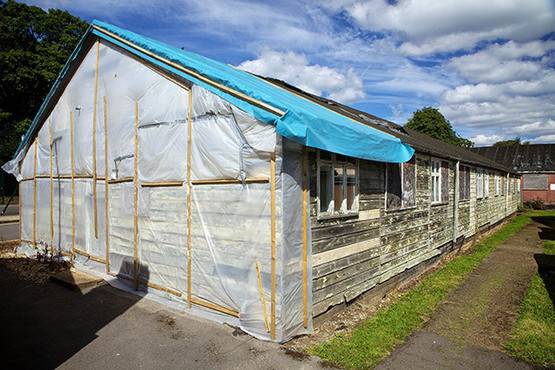| Codebreaking Materials Devised by Turing Discovered |
| Written by Alex Armstrong | |||
| Wednesday, 04 February 2015 | |||
|
During restoration work at Bletchley Park, papers which had been stuffed between the roof rafters to act as insulation were discovered and found to include unique surviving examples of Banbury Sheets.
At the end of World War II all the documentary evidence connected with breaking the communication codes of the German High Command was ordered to be destroyed. However, nobody thought to investigate the roof space!
In September 2013, as part of Bletchley Park's multimillion pound restoration project, work was undertaken on Hut 6, which in the 1940s housed the unit dedicated to breaking German army and air force messages. It was here that builders discovered documents relating to codebreaking activities, as well as other papers including parts of an atlas and a fashion article from a magazine, stuffed into holes in the wooden building's fabric.
Chief executive of the Bletchley Park Trust, Iain Stander, chief executive of the Bletchley Park Trust commented on the finds, which having been investigated and cleaned up, are about to go on display: “Discovering these pieces of code-breaking ephemera is incredibly exciting and provides yet more insight into how the codebreakers worked.” “The fact that these papers were used to block draughty holes in the primitive hut walls reminds us of the rudimentary conditions under which these extraordinary people were working.” Gillian Mason, Bletchley Park curator added“ These are the actual documents used by codebreakers, and in terms of the codebreaking process they are pivotal. I can just see these people beavering away. There is a lot of pencil and crayon activity.”
Among the documents recovered are examples of Banbury sheets, punch cards used in a codebreaking technique known as Banburismus which took its name from the town of Banbury where the cards were printed. Banburismus was a cryptanalysis procedure that took advantage of operator shortcomings in the Enigma encoding that could reveal the position of the rotor by noticing overlaps of letters in two messages. Banbury sheets were used to look for overlaps. Two cipher tests were punched onto different sheets and the sheets were slid past one another. In his account of Banburismus, which includes examples you can try for yourself, the late Tony Sale, original curator of the Bletchley Park Museum wrote: You may think that the punching into sheets was an over elaborate method for counting coincidences along two alphabetic strings. Not so, it is very difficult to spot coincidences in letter strings, especially doing it for long periods at high speed and under stress. The "holes" method, although more time consuming, was far more accurate, a vital necessity when dealing with very small statistical results. There doesn't appear to be anything written by Turing himself among the finds, but a notebook that does contain jottings he made is up for auction in New York in April, see Alan Turing Notebook To Be Auctioned More InformationAlan Turing's notes found being used as roof insulation in Hut 6 at Bletchley Park Related ArticlesBletchley Park awarded funds for historic restoration Tony Sale Award Established for Computer Conservation
To be informed about new articles on I Programmer, install the I Programmer Toolbar, subscribe to the RSS feed, follow us on, Twitter, Facebook, Google+ or Linkedin, or sign up for our weekly newsletter.
Comments
or email your comment to: comments@i-programmer.info |
|||
| Last Updated ( Wednesday, 04 February 2015 ) |





